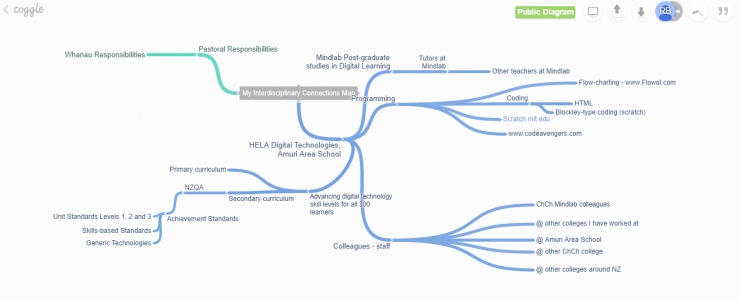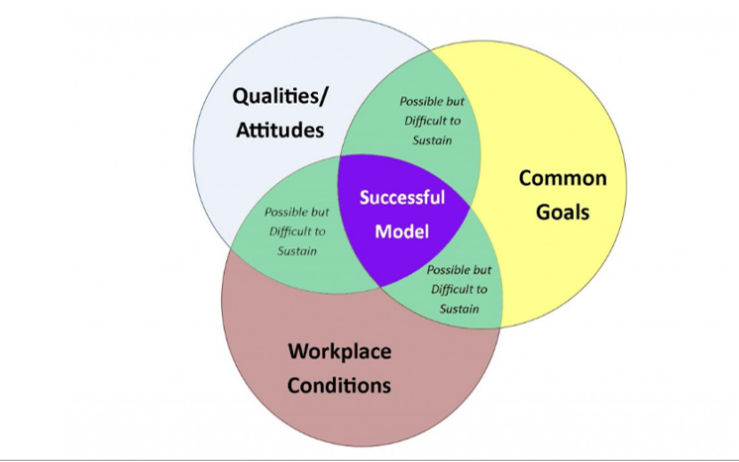What does interdisciplinary collaboration mean?
Andrews (1990) defines interdisciplinary collaboration as occurring “when different professionals, possessing unique knowledge, skills, organizational perspectives, and personal attributes, engage in coordinated problem solving for a common purpose” (#1)
“While multidisciplinary collaboration involves paralleled work of several disciplines, interdisciplinary practice may include inter-professional interactions in which two or more disciplines collaborate in the process of “joint planning, decision-making, and goal-setting” (#2)
Mindmap showing my current primary ‘Interdisciplinary’ connections

https://coggle.it/diagram/V8DFVp31HL0Yq5iv
While secondary teachers work within their subjects, my collaborations commonly involve working with teachers (interdisciplinary) from other departments to create better (i.e. richer) learning experience for our students. The 5-minute video below explains the benefits of providing interdisciplinary learning experience for students and how it can best be done: https://www.youtube.com/watch?v=cA564RIlhME
Why Adopt an Interdisciplinary Approach to Classroom Teaching?
I find it personally helpful to look on all subjects as being inter-connected and part of an organic whole. The idea behind STEM (Science, Technology, Engineering and Mathematics) is just that, only it focuses on the physical or tactile sciences. The explosion of STEM based teaching and learning has seen my needing to connect with the hard materials teacher at our school in order to upskill myself on 3-D printing/programming. Spatial intelligence is not a skill that I have had to work with before in any capacity but I have noticed that my students are more adept at picking it up than I am so perhaps it is not crucial that I am (due, I suspect, to being immersed in screens that involve 3D objects from a young age). The reality is that in a growing number of areas I am having to open myself up to various degrees of ‘flipped’ learning where students effectively become the expert teachers for a topic. That is as t should be to be honest; I would not be able to keep up with all the skills that I need to deliver my job to an expert level; so getting students to present their own expert learning certainly aids my situation and would represent a victory of common sense. Similarly, teachers sharing their approaches collaboratively across specialist areas is equally helpful and indeed often illuminating.
Truth be told, I do tend to see my own class teaching as being just as much a symbiotic process (both inside and outside the school gates) than collaborative as teachers and parents have always assisted each other across subject, vocational and professional responsibilities for the greater good of the learners (e.g. fundraising campaigns for sports trips). Researcher Gene Campanale of St Mary’s College, Notre Dame, Indiana also though as much as well (#3)
“Broadening perceptions of professional learning communities means rethinking notions of specific ‘location’…Professional learning communities can cross boundaries, both the fuzzy social differentiations that develop between groups within the school, and the clearer borders that separate the school’s members from those in the community and in other schools. As with any boundary crossing, expanding our ideas about ‘who belongs’ presents challenges to the existing culture.” (#4)
Who will I want to have an interdisciplinary connection with in the future?
Practitioners of STEM will be my primary target for professional connections in the future as it seems that this cross-disciplinary approach is the one that will yield the best results for the learners in my subject (digital technologies). The emphasis will almost certainly be on 3D-printing and design. Hopefully, the improvements in dexterity that are required in the spatial intelligence of both genders in this discipline may go some way towards replacing the tactile skills that have been lost through the reduction of hand-writing as an essential skill in our primary schools (which is also reflected in classrooms around the world. At what point in the last 10 years did holding a pen hold such limited importance? At about the same time we stopped teaching touch-typing in schools I would wager).
How might this joint planning, decision-making, and goal-setting take place?

Above: A conceptual model for successful interdisciplinary collaboration (#5)
Pre-Conditions Required for a Conceptual Model for Successful Collaboration
| Workplace Conditions | Qualities/Attitudes | Common Goals |
| § Regular communication
§ Standing meetings § Physical space § Administrative support |
§ Cooperative—able to compromise
§ Equitable—respect for roles § Trust—perceived competence § Shared vulnerability—safe setting to explore, inquire & critique § Enthusiasm—desire to continue collaboration |
§ Identify individual strengths
§ Select conference & publication venues that “count” for both, or alternate § Establish research “pipeline” & philosophy § Articulate/update timelines |
Benefits and Challenges of Interdisciplinary Practice in Relation to 3D Printing.
The benefits for the learners is that they can be exposed to the learning required to integrate software with real-life (STEM) problems that they can identify with. Note that it would certainly be advantageous for the educator(s) concerned to teach the students involved a little about group dynamics and team work to avoid unnecessary conflict and time-wasting about roles.
Conversely, teachers will certainly be needed to upskill in a number of areas, namely, that of using 3D software and becoming adept at the printing of student outcomes. When it is done well, the results can be startling as will be seen from the example below:
Interdisciplinary Collaboration Case Study:
Location: Radford University, Virginia, USA.
Instructors:
- LJ Clellan, UG Student Team Instructor & Coordinator
- Julia Castleberry, Doctoral Student Instructor & Coordinator
- Ty Esham, Hardware kit supplier and Robohand design consultant
These three expert practitioners “took advantage of three convergent trends:
(a) the emergence of low-cost 3D design software and fabrication
(b) the increasing adoption of the “lean startup” approach in modeling new ventures and
(c) the economic cost of healthcare in the U.S. is development of alternative, affordable services and products to provide access for both served and un-served patient populations” (#6).
The Nature of their Collaboration
First, they developed bridging between disciplines on campus and with communities of practice in the regional economy. Delivery of health care devices and services in affordable, innovative ways requires cross-disciplinary and multi-stakeholder participation and coordination. Enhancing students’ awareness and engagement in such complex problem-solving is excellent preparation for the school-to-work transition. Secondly, this project advanced peer-to-peer education in preparation for problem-centered, applied learning in a time constrained, professional environment. This project promoted “learning-by-making” through the application of new 3D design and fabrication technology fostering creative and innovative thinking about patient needs. Sometimes referred to as “blended reality,” this approach mixes digital and physical technology. Lastly, a complementary high-impact practice to this problem-centered approach was the “gamification” of outcome rewards for students during a simulated “Shark Tank” investor pitch contest.
Skills
Design, prototyping, 3D printing, manufacturing, patient care, customer research, business model development.
Software and Hardware Tools Used:
CAD design software, 3D printers, assembly and finishing hand tools.”
(#7)
=============================================================
(#1) cited in Berg-Weger &. Schneider, 1998.
(#2) American Association of Colleges of Nursing, 2016, p.1
(#3) ‘Schools and Community – A symbiotic relationship”; Gene Campanale, St Mary’s College, Notre Dame, Indiana. http://www.tandfonline.com/doi/abs/10.1080/01626620.1985.10519267
(#4) Stoll, L &, Seashore Louis, K. (Eds.).(2007). Professional Learning Communities: Divergence, Depth And Dilemmas. New York, NY: McGraw-Hill
(#5) http://acrlog.org/2015/05/14/a-conceptual-model-for-interdisciplinary-collaboration/
(#6) An Interdisciplinary Collaboration to Evaluate the Implementation of 3D Design and Printing Technology on Prosthetic Availability, User Value, and Commercial Viability
(#7) Collaborative research leads to 3D prosthetics prototypes http://www.radford.edu/content/radfordcore/home/news/releases/2015/april/collaborative-research-leads-to-3d-prosthetics-prototypes.html
Symbiotic & collaborative makes sound sense.
LikeLike
Wow, what an epic post Robert. As a primary teacher, we are developing our philosophy around using rich tasks for maths. This has proven to be ALOT more engaging for children, although takes a bit to get your head around to do so effectively. We also try to do a lot of ‘real world’ learning. To be completely honest, I still feel stymied by the emphasis placed on the 3 Rs reading, writing and arithmetic. What about the 21st century 4 Cs?? Communication, collaboration, creativity and critical thinking. Many parents are ultimately concerned about where their child is in relation to National Standards. Primary schools are traditionally still doing numeracy and literacy up until lunch time.
I agree with what you say about the learners being the experts. I have some very switched on coders and robotics creators. It’s good to utilise learner expertise after all, the teacher is the learner too.
LikeLiked by 2 people
As a member of a STEM team I agree that you as a Digital Technology expert bring skills to the team which are needed. Our Leader of Technology Learning has been guiding us regarding the design process. We find we are constantly needing him to bring us back to this process as we develop our STEM projects. As yet we have not ventured into the 3D printing sphere. We are beginning with projects which result in items produced from paper, wood, clay, and other such resources. I am interested in your inference that 3D printing is essential in a STEM programme. We do have a 3D printer, but it was a budget model which has already struck problems and is not an option for students of STEM at this stage. The 3D printing may have to wait until we have access to reliable printers.
LikeLiked by 1 person
Thanks Julie. It’s our first year of a STEM program and we are also working through the same problems you mention above. It’s certainly been a learning curve for us all and continues to be for us and many other schools that’s I’ve corresponded to (so I guess we are all in the same boat).
Kia kaha
LikeLike